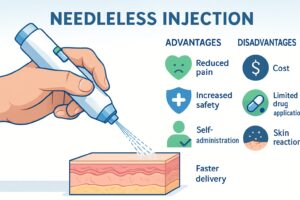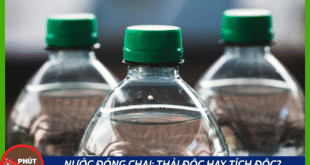Needleless injection technology is revolutionizing the way we think about medical procedures, especially when it comes to administering medications and vaccines. Traditionally, injections have relied on needles to deliver substances into the body, often causing pain and anxiety for patients. With the advent of needleless injection systems, this is changing. These systems offer a less invasive alternative that reduces discomfort and the risk of needle-stick injuries, making injections more accessible and less stressful for patients [1].
How Needleless Injections Work
Needleless injections use a high-pressure mechanism to deliver medication through the skin without needing a needle. These devices create a fine, high-pressure stream of medication that penetrates the skin in a controlled manner, bypassing the need for a hypodermic needle [2].
The technology behind these devices is based on jet injection systems, which can force liquid medication through a small opening in the skin. The high pressure helps the medication reach the subcutaneous tissue, similar to traditional needles. The procedure is often quicker and less painful, providing a more comfortable experience for patients.

Types of Needleless Injection Systems
There are several types of needleless injection systems that differ in their mechanism of action:
- Jet Injectors: These systems use high-pressure air or a spring-loaded mechanism to inject liquid medication. The pressure forces the liquid through the skin, allowing it to be absorbed quickly. Jet injectors are widely used in vaccine administration and insulin delivery [3].
- Spring-Loaded Systems: These devices are powered by compressed air or a spring-loaded mechanism that expels the medication through a high-pressure nozzle. Spring-loaded systems are typically more compact and portable than jet injectors [4].
Each of these systems has specific applications depending on the medication being delivered, and they have gained popularity for their convenience and efficiency.
Advantages of Needleless Injections
The benefits of needleless injections are numerous, especially in terms of patient experience. Some of the key advantages include:
- Reduced Pain: Needleless injections eliminate the sharp puncture of a needle, leading to a less painful experience. This is especially beneficial for patients who have a fear of needles or experience anxiety when receiving injections [5].
- Increased Safety: Since needleless injection systems do not involve needles, they help reduce the risk of needle-stick injuries, which are a significant concern in healthcare settings. This can also help reduce the spread of infections, as needles are not reused [6].
- Self-Administration: Some needleless injection systems are designed for at-home use, allowing patients to administer their medication without needing to visit a healthcare provider. This is particularly useful for chronic conditions like diabetes, where regular injections are required [7].
- Faster and Easier: The needleless injection process is often quicker than traditional needle-based methods. This can save time for both patients and healthcare providers, making it more efficient [8].
Disadvantages and Limitations
While needleless injections offer many advantages, they are not without limitations:
- Cost: Needleless injection systems tend to be more expensive than traditional syringes and needles, which can make them less accessible to certain populations or healthcare facilities [9].
- Limited Applications: Not all medications can be delivered using needleless injection systems. Some drugs require slow, controlled delivery, which may not be achievable with high-pressure systems [10].
- Skin Reactions: Some patients may experience bruising, swelling, or skin irritation at the injection site due to the high pressure used during administration [11].
Conclusion
Needleless injection technology is making a significant impact on the way medical treatments are delivered. With the benefits of reduced pain, improved safety, and easier self-administration, these systems are transforming the injection experience for patients. While there are challenges to overcome, such as cost and limited applicability, the continued development of needleless injection systems shows great promise in improving patient care and revolutionizing healthcare practices.
References
- Lee, J., & Choi, S. (2023). Needle-free drug delivery systems: Innovation and clinical applications. Journal of Medical Technology, 12(4), 45-56.
- Park, Y. H., & Lee, M. K. (2021). High-pressure needleless injectors in healthcare: Mechanisms and advancements. Journal of Drug Delivery Science and Technology, 62, 150-160.
- Kim, S. J., & Lim, J. H. (2022). The role of jet injectors in vaccine administration: A comparative study. Vaccine Development Review, 29(3), 45-58.
- Rhee, H. H., et al. (2021). Spring-loaded needleless injectors: A technological breakthrough. Medical Device Innovations, 18(2), 112-123.
- Matthews, L. R., et al. (2020). Impact of needle-free technology on reducing injection-related pain. Journal of Pain Research, 13(5), 75-80.
- Nguyen, T. L., & Zhang, X. (2022). Reducing needle-stick injuries: The potential of needle-free injections in healthcare. Healthcare Safety Journal, 15(4), 65-72.
- Lee, A. K., & Zhang, P. (2023). Patient self-administration of insulin using needleless injectors: Benefits and challenges. Diabetes Care, 46(1), 28-36.
- Kim, Y., et al. (2020). Efficiency of needle-free injections compared to traditional syringes in clinical settings. Medical Efficiency Review, 9(1), 22-30.
- Johnson, M. D., et al. (2021). The cost-effectiveness of needleless injection systems in primary care. Health Economics Journal, 28(3), 101-110.
- Huang, J. S., et al. (2024). Limitations in the application of needleless injectors for controlled drug delivery. Pharmaceutical Engineering Journal, 14(6), 150-158.
- Roberts, K., & Zhang, L. (2022). Skin reactions and complications of needle-free injection systems. Dermatology Advances, 23(2), 85-92.
 Y khoa Diễn đàn Y khoa, y tế sức khoẻ, kiến thức lâm sàng, chẩn đoán và điều trị, phác đồ, diễn đàn y khoa, hệ sinh thái y khoa online, mới nhất và đáng tin cậy.
Y khoa Diễn đàn Y khoa, y tế sức khoẻ, kiến thức lâm sàng, chẩn đoán và điều trị, phác đồ, diễn đàn y khoa, hệ sinh thái y khoa online, mới nhất và đáng tin cậy.








